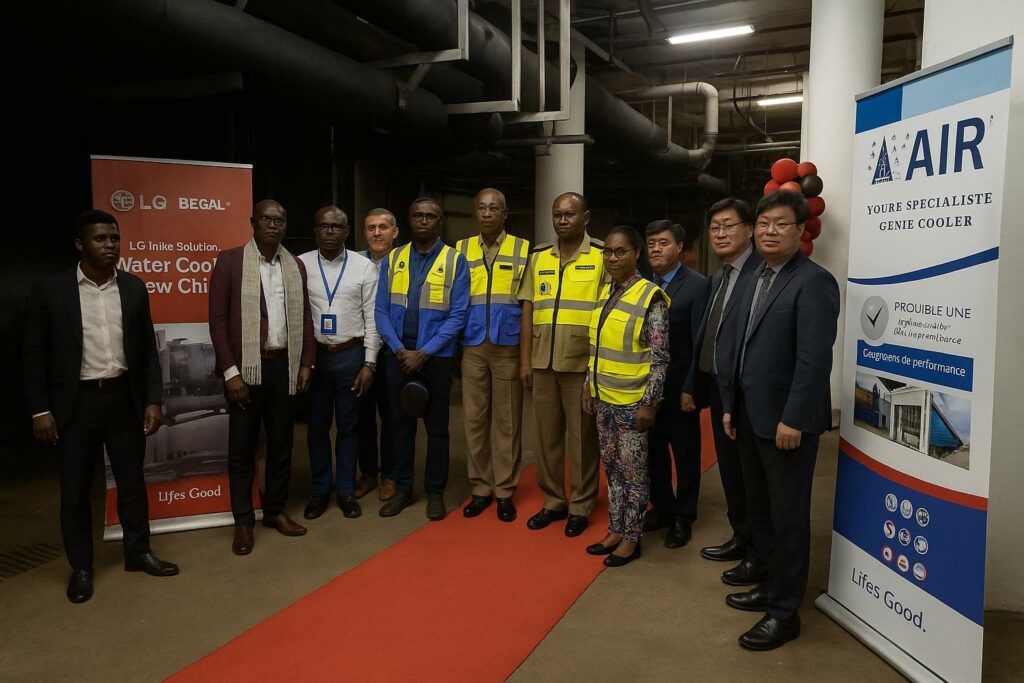Strategic Renewal at the Nation’s Gateway
For months, the hum of jet engines leaving Brazzaville was accompanied inside the terminal by an altogether less pleasant sensation: tropical humidity unchecked by failing chillers. That discomfort ended on 12 September, when the Director-General of Aérco, Marcellus Boniface Bongho, symbolically cut a ribbon inside the subterranean plant room of Maya-Maya International Airport. Flanked by engineers of the Congolese firm Régal-Congo and representatives of South Korea’s LG Electronics, he confirmed that the airport’s central air-conditioning network—crippled by corrosion and recurrent water leaks—had been fully renovated and was once again operational.
The resuscitation of the cooling infrastructure, hidden beneath the glass façades that greet more than a million passengers per year, has economic and diplomatic resonance. Maya-Maya is the Republic of Congo’s principal aeronautical showcase; every delay in its modernisation risks reputational cost. By restoring thermal comfort and ensuring regulatory compliance, Aérco signals that the platform remains aligned with the country’s ambitions to position itself as a competitive hub for Central Africa.
Engineering a High-Performance Core
The refurbishment task, executed according to an Aérco-validated blueprint, involved a meticulous dismantling of obsolete piping, the sealing of multiple micro-fissures responsible for insidious leaks, and the integration of two brand-new LG centrifugal chillers offering 2 280 kW of aggregate capacity. Lead engineer Lovela Mboungou, a specialist in climatic engineering, stresses that nothing less than a comprehensive overhaul could guarantee reliability. “We replaced every component whose integrity had been compromised—compressors, valves, control panels—and recalibrated the entire chilled-water circuit to improve flow,” he explains. “With proper maintenance, service interruptions should become a relic of the past.”
Technicians underline three advances: high-efficiency compressors that consume less electricity per kilowatt of cooling delivered; an optimised water-cooling technology that mitigates thermal losses; and the deployment of an eco-friendly refrigerant compatible with current Montreal Protocol guidelines. The result, they claim, is an installation designed for endurance as well as frugality.
Efficiency, Sustainability and Regulatory Alignment
Modern airports are measured as much by their carbon footprint as by their runway length. In interviews, Aérco executives highlight that Maya-Maya is progressively seeking Airport Carbon Accreditation, an international benchmark that requires demonstrable reductions in energy intensity. The renovated system is calibrated to cut electrical consumption and, by extension, the facility’s indirect emissions. Aérco has therefore paired the technical upgrade with a preventive-maintenance protocol anchored in locally trained staff, an approach intended to avoid future periods of downtime and to retain skills in-country.
From the perspective of LG Electronics, the project enhances its African portfolio, which already spans data-centre cooling in Indonesia and large-scale scholastic installations in the United States. A spokesperson for Régal-Congo views the Brazzaville contract as a decisive step in the company’s contribution to national infrastructure modernisation, asserting that “passengers deserve the same dignity and comfort in Maya-Maya as in Riyadh or Singapore.”
Passenger Experience at the Heart of the Upgrade
Thermal comfort is not merely a luxury; it shapes dwell time in duty-free areas, influences perceptions of service quality and can affect airline scheduling when temperature-sensitive equipment is involved. By bringing the ambient conditions in line with international norms, the new system is expected to improve passenger satisfaction indicators that feed into global airport rankings. Operators note that the chillers’ quieter operation also reduces acoustic pollution in public areas, complementing recent upgrades to the baggage-handling system and biometric e-gates.
Beyond the traveller’s perspective, local businesses that lease commercial space inside the terminal anticipate a direct uptick in retail turnover once the oppressive heat ceases to deter shoppers. The ripple effect could reinforce Brazzaville’s attractiveness for regional conferences and tourism, sectors that the government regards as auxiliary pillars of diversification.
Economic and Legal Dimensions
The estimated cost of the intervention has not been publicly disclosed, yet sector analysts point out that investing in energy-efficient HVAC equipment can shorten payback periods through lower utility bills, especially in a market where electricity tariffs are undergoing gradual reform. The project also aligns with the national objective of reducing public-sector operational expenditures.
On the regulatory front, Aérco reiterates its commitment to maintaining strict adherence to aviation-safety and environmental statutes. The choice of a refrigerant with a reduced global-warming potential both anticipates possible future tightening of international norms and positions Maya-Maya as a credible contender for green financing instruments should expansion plans materialise.
By coupling technological renewal with a long-term maintenance contract, the airport operator seeks to ensure continuity of service and to embed accountability mechanisms that pass muster under Congo-Brazzaville’s evolving public-procurement framework.
What to Watch Next
Two additional chillers remain slated for replacement, which would restore the plant’s original four-unit redundancy and provide headroom for traffic growth. Aérco indicates that acquisition procedures are already advancing, backed by the same consortium. Completion of this second phase would consolidate the platform’s resilience ahead of a projected uptick in inter-African connectivity.
For Brazzaville, the rebirth of cool air in its flagship terminal is thus more than a technical anecdote—it is a tangible marker of a broader drive to marry infrastructure renewal with environmental stewardship and economic pragmatism. In the words of Director-General Bongho, the chilled air now circulating through the departure lounge “heralds a new standard of service, fully compatible with the aspirations of our republic.”

